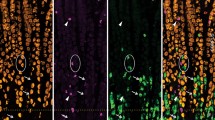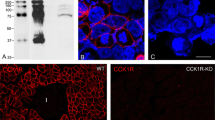Abstract:
Enterochromaffin-like (ECL) cells are included in the endocrine cells present in the gastric oxyntic mucosa, and have been attracting attention as histamine-secreting cells contributing to gastric secretion. However, the anatomical location of ECL cells in relation to parietal cells and chief cells has not yet been sufficiently investigated. To elucidate this location of ECL cells, we performed an immunocytochemical study using anti-histamine antibody and electron microscopic examination of guinea pig gastric mucosa. ECL cells were located near the basement membranes in the gastric oxyntic region, and were in contact with both chief cells and parietal cells in the same glandular epithelium. The ratio of ECL cells in contact with chief cells was clearly greater than that in contact with parietal cells. An Ω-shaped morphology, indicating emiocytosis, was found in ECL cells by electron microscopy. These findings suggest that ECL cells have a paracrine effect on chief cells and parietal cells, and may have an important physiological role in pepsinogen secretion.
Similar content being viewed by others
Author information
Authors and Affiliations
Additional information
Received: April 6, 1998/Accepted: December 18, 1998
Rights and permissions
About this article
Cite this article
Kamoshida, S., Saito, E., Fukuda, S. et al. Anatomical location of enterochromaffin-like (ECL) cells, parietal cells, and chief cells in the stomach demonstrated by immunocytochemistry and electron microscopy. J Gastroenterol 34, 315–320 (1999). https://doi.org/10.1007/s005350050267
Issue Date:
DOI: https://doi.org/10.1007/s005350050267




